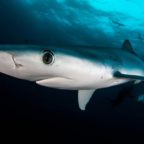
Standing on a balcony lit by San Diego sun, wildlife videographer Scott Fairchild thumbs the throttle of his drone controller. As the drone flies over breaking waves, he sees what he normally sees: some surfers, a swimmer, and a great white shark.
As the lone swimmer drifts away from others in the water, he seems to pique the shark’s interest. It changes course and starts to follow. A hundred yards from shore, this is the exact location of a 2008 fatality caused by a white shark, where a swimmer was “bit in half,” Fairchild tells me later, training for a triathlon.
The shark sinks into murky water, then resurfaces. It veers off to the side, then returns. The swimmer’s arms take turns splashing the water around him, and the shark speeds up, closing the gap between them.
Unable to alert the swimmer, Fairchild pulls out his phone and prepares to dial 9-1-1. He faces a tough question: Should he keep recording or turn the camera off?
The shark keeps trailing, a mere 10 feet from the swimmer and closing, before something changes. The shark stops, turns the other way, and is gone out of sight.
For years, Fairchild has recorded interactions like these along the San Diego coastline. Thousands of hours, and this is the closest to an adverse encounter with a white shark he has seen.
In a study published by PloS One in June, researchers at University of California Shark Lab found that in juvenile white shark aggregation zones in Southern California there is a 97 percent human-shark co-occurrence; where there is a white shark, there is almost always a surfer nearby.
To Shark Lab Director Chris Lowe, these numbers were surprising. In some areas, people are around white sharks more than they are aware, making negative encounters even rarer than previously thought.
“It’s incalculably rare,” Fairchild said. He and others hope that educating the public can help protect sharks, who are essential to the health of the ocean, and therefore the planet.
Currently, Lowe is quantifying these interactions and the circumstances by which the shark behaves. Preliminary analysis shows white sharks, at least around San Diego, generally ignore people.
“They treat people like flotsam,” he said. “We don’t chase them, we don’t harass them, and we’re not food.”
This isn’t true for all white shark populations. For reasons not yet known, footage such as Fairchild’s, of sharks peacefully passing beneath surfers day after day, hasn’t been duplicated elsewhere.
While California has seen two fatalities caused by white sharks in the last decade, the Global Shark Attack File, compiled by the Shark Research Institute, lists three in South Africa and 13 in Australia. According to the Australian Shark Incident Database, Australia sees three times the number of shark fatalities than the United States.
“Australia has less people than Southern California, but they get three or four attacks a year. We get one every four years,” Fairchild said. “Even though it is still incalculably rare, for whatever reason it’s almost always Australia and South Africa, even though there are great whites up and down California, up and down Mexico, up and down the [US] Northeast.”
Researchers are not able to explain these behavior differences, but they could be caused by any number of factors, Lowe said. It’s possible there are fewer marine mammals in certain parts of Australia, or that the marine mammal populations recover faster in the United States. More food means less desperation for the sharks to go out of their way for a meal.
White sharks in Australia may also have a more varied diet, said Andrew Fox, an Australian white shark researcher and son of shark-cage-diving pioneer Rodney Fox. In this case, mistaking a human for prey would be less of a stretch for them.
Variables persist down to the individual, Fairchild said. “Is the shark sick when it eats us? Is it starving, is it unwell, is it bored? Why does one guy pick a fight at a bar, and you don’t?”
The higher fatality rate in other parts of the world could have more to do with people than sharks, Lowe said. After conducting case studies with emergency department physicians in Southern California, he found that non-lethal shark bites might have been deadly in other parts of the world. Southern California is unique in its range of cell service and number of high-density trauma centers. Fatalities are often a matter of place and time, not the shark.
“If you get bit, and your femoral artery gets shredded, there’s not a whole lot you can do,” he said. “You’ve got basically two minutes to stop the bleeding before you bleed out, and that’s really hard to do when you’re out 200 yards off the beach.”
Among areas of high human-shark interaction, California is one of the few that doesn’t perform shark mitigation, such as culling—clearing sharks from whole stretches of coastline—in the hopes of preventing attacks. Governing bodies in both Australia and South Africa have been using lethal shark mitigation for over 50 years.
According to the Australian Marine Conservation Society (AMCS), both Queensland and New South Whales cull via shark nets and baited hooks. While governing bodies approve these actions, Fairchild sees them as dangerous.
“Australia is moronic in their approach,” Fairchild said. “They have all those drumlines, nets, which they’ve proven doesn’t work. One, you’re catching turtles and whales and killing things for no reason, and you’re catching things so the sharks come eat them. Now you’re bringing sharks in, so it’s such a horrible approach, and everyone knows it.”
Since 2001, Queensland’s shark nets and drumlines have caught 413 whales and dolphins, 907 turtles, 1,766 rays and culled 13,167 sharks, AMCS reports.
Culling is often practiced in Australia after the actions of an individual shark without proper research on their population, Fox said.
“By culling, technically, you need to know how many there are and how many you need to remove to make a certain measurable impact,” he said. “But nobody even knows how many there are and how many would need to be removed. It’s only a temporary thing where a shark may be a problem in a little area.”
No one wants to be blamed for the next shark attack, Fairchild said, which is likely why these practices persist.
It will be a long time, if ever, before research will be able to definitively predict shark behavior for populations across the globe, Lowe said.
Many species of animals show different behaviors geographically, Fairchild said. In South Africa and almost nowhere else, white sharks are recorded fully breaching out of the water.
“They literally hunt differently. They act differently,” he said. “It’s no different than saying South African people or Californian people. Same with sharks. And then even individualistic—even if you were my neighbor, and we both live in San Diego, you and I are different.”
Lowe said it’s less about the ability to predict behavior, but the need. While shark attacks are recorded in higher frequency in other aggregation sites around the world, compared to the number of peaceful interactions in those places, adverse interactions are still very low.
Shark attacks get a lot of attention, but water presents much greater danger. The International Shark Attack File reports a recent average of six human deaths caused by sharks globally per year. According to Stop Drowning Now, 320,000 people drown per year. It might be some of the attention itself that leads to attacks. White shark attacks in Australia tend to overlap with public interest; where sharks have been reported, there often is an attack in the following days. Lowe calls it a conservation success challenge. As more people learn about sharks, the more they go out and want to see them, which often means chasing them or altering their behavior in some way, putting people at greater risk.
“It seems to be a lot of drama when we come across them, but they live there,” Fox said. “The ocean is a better place for the sharks being there.”
Paying attention to wildlife can help reduce risk. Reports of sharks and knowledge of marine activities — when tuna migrate inshore, where pelagic fish and seals aggregate, the seasons for whale calving and dolphin pupping—help ocean-goers know when to stay away from areas where there might be increased shark feeding. Dawn and dusk are potentially more dangerous, because sharks are harder to see.
“(It’s) a way of making a rare occurrence even rarer,” Fox said.
Much less rare is the killing of sharks by humans. While sharks kill an average of six people per year, a Dalhousie University study found humans kill over 100 million sharks per year, mostly targeting them for shark fin soup. These are reported shark kills, with the unreported number potentially much higher.
Sharks are a keystone species, having a disproportionately large effect on their ecosystem. Sharks are essential in keeping prey populations diverse, which keeps coral reefs and seagrass beds alive and healthy. Healthy oceans mean a healthy planet. According to the National Oceanic and Atmospheric Administration, most of the world’s oxygen comes from the ocean.
“They do a great job of trying to balance an environment that we seem to be hell-bent on messing up with pollution and overfishing,” Fox said. “They perform an important role with trophic cascades and top-down regulation to make the whole ocean a more rich and diverse and healthy environment that we love to go into. The presence of sharks indicates a healthy ocean.”
Lowe is working to predict aggregation zones in the future by factors such as temperature and prey availability. These hotspots tend to last one to five years, so the San Diego nursery will likely move on soon.
Lowe said there are two bigger factors that may sway white shark hotspot predictions. The first is the changing climate. Sharks are moving farther north than ever before. The second is public education. Data suggests white sharks in Southern California largely ignore the people in the water, but people are just starting to learn the sharks are there at all. That means humans are not chasing or harassing the sharks. If human behavior changes, so could sharks’, so educating people to understand they are not typical prey for sharks is important.
Fairchild saw firsthand the power of education in overall shark perception. When he first started posting his drone footage on Instagram, he received many comments from people claiming the videos were not of white sharks at all.
“People start saying the nose is too pointy, but they’re literally called ‘pointer sharks.’ They’re incredibly pointy,” he said. “I realized all people knew is the face shot of a great white. All they’ve ever seen is it biting. All people know is that open mouth, bloody teeth, jaws. They’ve never seen a great white that has blue eyes and not a black hole of death behind it.”
Fairchild started recording sharks for fun, but it has inadvertently turned him into a bit of a citizen scientist and advocate.
“I watch it,” he said. “I’ll be standing on a bluff. There will be like 35 great whites in my line of view, and there are surfers and swimmers everywhere, and they go out of their way, like they are annoyed by them if anything. If they wanted us even a little bit, they could literally just go up and down the coast and take a surfer, take a swimmer, take a surfer, it’d be effortless. We, for whatever reason, and thank God we’re not, we are not a part of the diet.”















Social Profiles